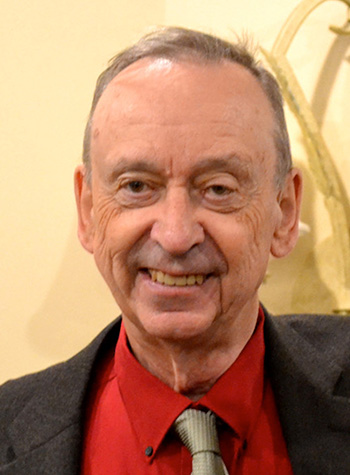Inducted October 2020

David L. Peters dedicated his professional life to advancing modeling and simulation visual systems technologies. As a pioneer, he led a team that transformed visual systems for the modeling, simulation and training (MS&T) industry and the aviation community. These advancements impacted and continue to be used today on planes such as the F-22, F-15, T-7A, P-3C, and the AH-64 Apache helicopter, among others.
He holds 18 patents., and Pperhaps the most impactful is for the “‘Eye-Line of Sight Responsive Wide-Angle Visual System”’ that provided an optical dome system with an eye-tracking, servo-driven projection system. It provided 360-degree coverage and tracked a pilot’s view, — a leap forward for pilot training and MS&T. Mr. Peters led the team that developed the first successful FLIR forward-looking infrared (FLIR) simulation for the AH-64 Apache helicopter trainer introduced in 1985, chosen as the U.S. Army Weapon of the Yyear, the first for simulation.
Dave Mr. Peters and his team also developed the first graphics processing unit (GPU) computing architecture to render native source data without the need for advanced compilation. This technology is still in used today by the Department of Defense and commercial simulators. His work has changed the course for visual simulations and made a lasting impact on modeling, simulation and training.
David Peters graduated with his bachelor’s degree in electrical engineering from the University of Dayton in 1959 and worked for Hazeltine Research Corporation. He became project lead, working under the direct supervision of the company’s president, Barnard D. Loughlin – inventor of the NTSC broadcast system – and developed several innovative television-based systems in very high resolution (greater than 1000 line), and many for simulation-based displays. Mr. Peters also learned eye-color/brain relationships and studied modulation transfer analysis of visual systems.
He became a project design engineer with Link Flight Simulation in 1971, worked on innovative display generation systems, and went on to lead the introduction of modulation transfer analysis of display systems within the company. Mr. Peters started as team leader in 1976 in the proposal department where he concentrated on all visual proposal efforts, which eventually included image generation efforts in Link’s Advanced Products Operation division. In 1984, he began leading the technical team, whose successful FLIR efforts brought about the award-winning Apache helicopter simulator.
Mr. Peters co-founded Diamond Visionics, LLC, in 1996 with his partners. As the company’s technical director, he designed and developed a special display for the Army’s CCTT program, a tank popped-hatch 360-degree display. Mr. Peters also led efforts that brought Diamond Visionics a Tibbets Award from the SBIR program, and later became the firm’s chairman. He is still actively involved with the business he co-founded.
Mr. Peters became a recognized contributor to using modulation transfer function analysis in total usefulness and response of visual systems in manned simulation systems. He led all major visual proposal efforts at Link Flight Simulation for many years and became recognized as one of the industry’s leading knowledge-based authorities on FLIR sensor training.
Possibly his most interesting patent, the “Eye-Line of Sight Responsive Wide-Angle Visual System,” was featured on the cover of Scientific America’s July 1986 issue. This invention was a foveal-driven optical display dome system that used an eye-tracked, servo-driven projection system that could be constructed for 360-degree coverage with eye-limiting resolution wherever the pilot looked, using only two channels of 1000-line image generation systems. Two were built for the British air force.
Mr. Peters has guided the technical direction of Diamond Visionics since its beginning and continues to influence its direction today, coordinating with all leading staff members. He led the company’s design efforts on the display system for the Army that earned the Tibbetts Award, and he continues consulting efforts for non-competing companies.